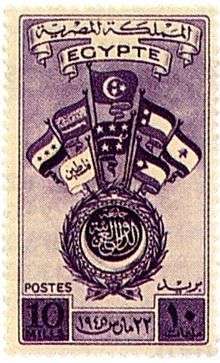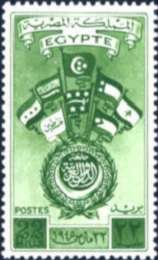History of the Arab League
In its early years, the Arab League concentrated mainly on economic, cultural and social programs. In 1959, it held the first Arab Petroleum Congress, and in 1964, established the Arab League Educational, Cultural, and Scientific Organization. In 1974, despite objections by Jordan, the league recognized the PLO as the sole legitimate representative of all Palestinians.
| Part of a series on | ||||||||
| Arab League | ||||||||
|---|---|---|---|---|---|---|---|---|
 | ||||||||
|
Issues
|
||||||||
|
||||||||
|
Governance
|
||||||||
|
||||||||
|
||||||||
|
||||||||
|
|
||||||||
|
||||||||
|
Culture
|
||||||||
| Historical Arab states and dynasties | ||||||||||||||||||||||||||||||||||||||||||||||||||||||||||
|---|---|---|---|---|---|---|---|---|---|---|---|---|---|---|---|---|---|---|---|---|---|---|---|---|---|---|---|---|---|---|---|---|---|---|---|---|---|---|---|---|---|---|---|---|---|---|---|---|---|---|---|---|---|---|---|---|---|---|
 | ||||||||||||||||||||||||||||||||||||||||||||||||||||||||||
|
Ancient Arab States
|
||||||||||||||||||||||||||||||||||||||||||||||||||||||||||
|
Arab Empires
|
||||||||||||||||||||||||||||||||||||||||||||||||||||||||||
|
Eastern Dynasties
|
||||||||||||||||||||||||||||||||||||||||||||||||||||||||||
|
Western Dynasties
|
||||||||||||||||||||||||||||||||||||||||||||||||||||||||||
|
Arabian Peninsula
|
||||||||||||||||||||||||||||||||||||||||||||||||||||||||||
|
East Africa
|
||||||||||||||||||||||||||||||||||||||||||||||||||||||||||
|
Current monarchies
|
||||||||||||||||||||||||||||||||||||||||||||||||||||||||||


The League was weakened over the years by internal dissensions on political issues, especially those concerning Israel and the Palestinians and later on by the three Gulf wars. After Egypt signed a separate peace treaty with Israel on March 26, 1979, other Arab League members met in Baghdad and voted to suspend Egypt's membership and transfer the League's headquarters from Cairo to Tunis. In May 1989, nine years later, Egypt was readmitted and resumed membership. The headquarters returned to Cairo in 1990.[1] This step was sharply disputed as members of the League were deeply divided over the Kuwait crisis and the invitation extended by Saudi Arabia to the United States, which allowed foreign military build-up in its Eastern province. The League was effectively paralyzed by the eruption of the Gulf crisis, and its future as a regional organization became highly uncertain.
Until the Israeli–Lebanese war in the summer of 2006, the League had started making positive moves and was starting to regain respect with the Jewish public and media.
Foundation
Arab citizens in general perceive themselves as one people divided among a number of states with history, geography, language, culture, and socio-economic interests propelling them to forge one great Arab Nation (Arabism). The British Empire realized this in the early part of the twentieth century, which helped them secure the cooperation of the Arabs, leading them to revolt (Arab Revolt) against the Turkish Ottoman Empire during World War I. The British promised to help the Arabs establish a united Arab kingdom under Sherif Hussein of Mecca, which would encompass the Asian part of the Arab World (including the modern day Arabian peninsula, Iraq, Syria, Lebanon, Palestine, Israel and Jordan). After winning the war, however, the British betrayed Sharif Hussein and instead helped divide the region into mini states, implementing their policy of "Divide and Rule".(Sykes–Picot Agreement).
The British needed Arab cooperation once more during World War II, and again returned to play the Pan Arabism card by encouraging the formation of the League. Many Arab intellectuals believe that the British did not want the League to act as a step towards Arab unity, but actually used the League to prevent it.
Proposed names
Several suggestions were made for the name of the organization: Iraq suggested Arab Union; Syria suggested Arab Alliance; and Egypt proposed the Arab League. Egypt's proposal was adopted, and later amended to the League of Arab States.
Timeline
- 1942: The United Kingdom promotes the idea of an Arab League in an attempt to win over Arabs as allies in war against Germany.
- 1944: Official representatives from Egypt, Iraq, Lebanon, North Yemen, Saudi Arabia, and Transjordan meet in Alexandria, Egypt, and agree to form the League of Arab States.
- 1945: Arab states sign the Arab League Pact, formally inaugurating the League.
- 1945: Arab league member states declare a boycott of Jewish businesses in Palestine (continued after the establishment of Israel as the Arab League boycott).
- 1946: Arab League members sign the Cultural Treaty.
- 1947: The Arab League adopted the "Draft Law" governing the dispossession, de-naturalization and internment of Jews in Arab League States.
- 1948: 1948 Arab–Israeli War.
- 1950: League members sign the Joint Defense and Economic Cooperation Treaty.
- 1953: Members establish the Economic and Social Council; Libya joins the Arab League.
- 1956: Sudan joins the Arab League.
- 1958: Morocco and Tunisia join the Arab League; The United Nations recognizes the League and designates it as the United Nations' organization for education, science and culture in the Arab region.
- 1961: Kuwait joins the Arab League.
- 1962: Algeria joins the Arab League.
- 1964: The first summit convenes in Cairo; the Arab League Educational, Cultural and Scientific Organization (ALECSO) forms; a second league summit that autumn welcomes the establishment of the Palestine Liberation Organization (PLO).
- 1967: South Yemen joins the Arab League.
- 1967: The Arab League summit convenes in Khartoum. The Khartoum Resolution is issued.
- 1971: Oman, Bahrain, Qatar, and the United Arab Emirates join the Arab League.
- 1973: Mauritania joins the Arab League.
- 1974: Somalia and Palestine (represented by the PLO) join the Arab League.
- 1976: Arab League summit in Cairo authorizes the formation and deployment of an Arab peacekeeping force, mainly Syrian, in Lebanon.
- 1977: Djibouti joins the Arab League.
- 1979: The League suspends Egypt's membership in the wake of President Anwar Sadat's visit to Jerusalem and of Egypt's peace agreement with Israel; the Arab League moves its headquarters to Tunis.
- 1987: The Arab League unanimously endorses a statement on Iraq's defense of its legitimate rights in its dispute with Iran.
- 1989: The League re-admits Egypt as a member; the League's headquarters returns to Cairo.
- 1990 (May): A summit meeting in Baghdad criticizes Western efforts to prevent Iraq from developing advanced weapons technology.
- 1990 (August): At an emergency summit, 12 out of the 20 states present condemn the Iraqi invasion of Kuwait; unified Yemen joins the Arab League.
- 1993: Comoros joins the Arab League.
- 1994: The Arab League condemns the Gulf Cooperation Council's decision to end the secondary and tertiary trade embargo against Israel, insisting that only the Council of the Arab League can make such a policy change, and member states can not act independently on such matters.
- 1996: The Arab League Council determines that Iraq, Syria and Turkey should share the waters of the Euphrates and Tigris rivers equitably between them. (This followed complaints by Syria and Iraq that extensive construction work in southern Turkey had started to restrict their water-supply.)
- 1998: The Arab League Secretary-General condemns the use or threat of force against Iraq; Arab League interior and justice ministers sign an agreement to strengthen cooperation against terrorism; the Arab League denounces bomb attacks against U.S. embassies in Kenya and Tanzania and U.S. missile strikes against Afghanistan and Sudan.
- 2002: Arab Peace Initiative. During an annual summit in Beirut in March, the Arab League proposes full normalization of relations with Israel in exchange for Israeli withdrawal to the 1967 internationally recognized borders, implying Israeli evacuation of the West Bank, the Gaza Strip, east Jerusalem, the Golan Heights and a fair, negotiated solution for the return of the Palestinian refugees and their descendants to their homeland.
- 2002: Libyan leader Muammar al-Gaddafi threatens to withdraw from the League, because of "Arab incapacity" in resolving the crises between the United States and Iraq and the Israeli–Palestinian conflict.
- 2003: The League votes, 21–1, in favor of a resolution demanding the immediate and unconditional removal of U.S. and British soldiers from Iraq. (Kuwait casts the lone dissenting vote.)
- 2006: Arab League Members decide to break the sanctions against the Palestinian Government of Hamas, by letting its banks function inside the Gaza Strip, in response to a widely condemned incident in Beit Hanun, by Israeli Forces.
- 2007: Arab League delegation visits the State of Israel for the first time in history, to discuss the League's newly reaffirmed Arab Peace Initiative as well as the threat posed by Hamas and other Islamic extremists.
- 2011: Majority-black South Sudan votes to secede from Arabist-led Sudan. Revolutions topple the governments of Tunisia and Egypt. The Arab League suspends Libya after the Gaddafi regime responds to countrywide demonstrations by ordering the military to attack protesters. The suspension is lifted following Gaddafi's ouster. The Arab League suspends Syria in November 2011 for its own crackdown on protestors.
- 2017: Arab league expresses extreme concern over the dam Ethiopia is building on the Blue Nile.[2]
References
- Arab Unity - "Peace after the Yom Kippur War?" - Al Jazeera - Retrieved 31 January 2011.
- http://www.globalconstructionreview.com/news/arab-league-extreme-concern-over-ethiopias-nile-da/
